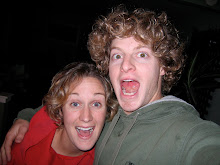The final segment of our bike journey in South America is a 700-mile stretch through the flat lowlands, or Pampa, of southern Patagonia. It is desert-like and barren. There are no trees, only small, hearty shrubs and grasses. The only people we ever see are those in vehicles whizzing between Torres de Paine and Glaciers National Parks. Aside from the hundreds of hares that can be seen darting across the road every couple of miles or the sheep grazing on the endless ranches, the only other wildlife we've seen are guanacos (deer/lama-like creatures), armadillos, rheas and a variety of other birds. There is not much to stop and see, yet the void of the Pampa is beautifully fascinating. And windy!
Armadillo
Guanacos
Mike on the Pampa
The wind here is unlike wind either of us have ever experienced. I find it difficult to actually call it wind as it's more like a violent, relentless monster who you can hear howling across the plains and who's voice is a deafening whistle that reverberates in your head; not even ear plugs can block the noise. There are times when it's actually manageable, but it never stops blowing and it will fight and rip you to shreds if you think you can beat it. When it's at your back, life on a bike couldn't be better. We don't have to exert an ounce of energy, yet can cover huge distances in no time. At one point we stopped, sat on our bikes without taking a single pedal stroke and before we knew it we were cruising along at 25mph. It takes a mighty strong wind to accelerate and push a 225-pound object at that speed. Once we began pedaling again we were flying up hills at unbelievable speeds and coming down at 45mph. It was thrilling and fun; if only it could always be that way.
However, it's inevitable that the road eventually turns and we find ourselves riding straight into the monster or having it attack us from the side. When it's blowing straight on, we can be in granny gear pedaling our hearts out, going downhill, and brought to a dead stop. If we stop pedaling for a second we'd be sent backwards, right back up the hill. The force is unfathomable. But the worst, by far, is when there is a side wind, which unfortunately is the majority of the time. We learned a lesson about battling a side attack our first day on the Pampa. There is no way to win.
First there is the base wind speed that blows constantly. It's cold and not fun to ride in, but it's possible; we just have to lean into it. Typically we only lean that far when we're going around curves and it feels (and looks) very unnatural to ride down a straight road in such a manner. If the wind would stop blowing for just a second, we'd probably topple over, but we don't have to worry about that. But what so often makes the side winds unrideable are the gusts. They hit you like a tidal wave and in less than a blink of an eye we find ourselves in the lane of oncoming traffic wondering what happened. It's impossible to stay in control and ride a straight line; our panniers are like sails and the wind grabs them and forces us to go wherever he desires. Not only is it frustrating and scary, it's stupidly dangerous as well.
Therefore, we've spent a fair amount of time walking our bikes, attempting to hold them upright with all of our strength while torrents of wind pummeled us with skin-piercing grains of sand, all while searching for a rare-to-find place to hide. Drainage ditches, huddled up next to ranchers' houses or tucked away in sheds have been our wind refuges on the Pampa, although even those places sometimes can't protect us. The wind tends to swirl around the buildings and even on the leeward side the simple act of setting up a tent is more like battling a giant octopus with the 8 guy lines used to stake down our shelter thrashing about madly in our faces. Two people are required for this task as one of us sprawls out over the tent making sure to keep a death grip on the tarp, rain fly and tent which would undoubtedly be ripped from your hands and 50 miles away in a matter of minutes while the other gathers the largest rocks they can find to hold us down our fort.
Mike trying to hold up his bike against the wind. Notice the yellow tent string on the back of his bike!
A shed we called home for a night.
We have spent many long days hanging out in our tent, waiting for the wind to ease, which generally only happens at night and then picks up again at 4:30 AM just when the sun begins to rise, and riding whenever possible. We set alarms for all hours of the night, check the wind when the buzzer goes off and if it's rideable, pack up camp, turn on all of our blinking lights and ride, regardless of the time. Despite the difficulties of staying awake, it's actually quite pleasant cycling at night; there is very little traffic and we can see it coming from miles away, we don't have to worry about being thrown off of our bikes and we can move along at more than a measly 3mph. It's not such a great way to see the scenery, but at times it's the only way that's possible.












































